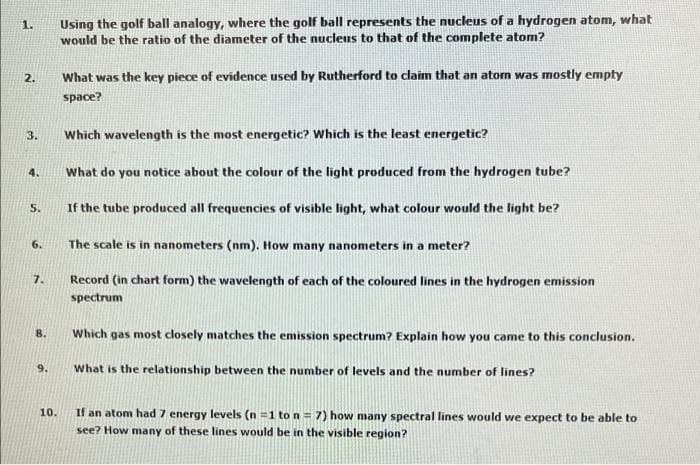Using the golf ball analogy, where the golf ball represents the nucleus of a hydrogen atom, what would be the ratio of the diameter of the nucleus to that of the complete atom? 1. 2. What was the key piece of evidence used by Rutherford to claim that an atom was mostly empty space? 3. Which wavelength is the most energetic? Which is the least energetic? 4. What do you notice about the colour of the light produced from the hydrogen tube?
Using the golf ball analogy, where the golf ball represents the nucleus of a hydrogen atom, what would be the ratio of the diameter of the nucleus to that of the complete atom? 1. 2. What was the key piece of evidence used by Rutherford to claim that an atom was mostly empty space? 3. Which wavelength is the most energetic? Which is the least energetic? 4. What do you notice about the colour of the light produced from the hydrogen tube?
Introductory Chemistry: A Foundation
9th Edition
ISBN:9781337399425
Author:Steven S. Zumdahl, Donald J. DeCoste
Publisher:Steven S. Zumdahl, Donald J. DeCoste
Chapter11: Modern Atomic Theory
Section: Chapter Questions
Problem 102AP
Related questions
Question
I already have my answers for some of them, but just wanted to double check...specially the last 4 questions...

Transcribed Image Text:Using the golf ball analogy, where the golf ball represents the nucleus of a hydrogen atom, what
would be the ratio of the diameter of the nucleus to that of the complete atom?
1.
2.
What was the key piece of evidence used by Rutherford to claim that an aton was mostly empty
space?
Which wavelength is the most energetic? Which is the least energetic?
3.
4.
What do you notice about the colour of the light produced from the hydrogen tube?
5.
If the tube produced all frequencies of visible light, what colour would the light be?
6.
The scale is in nanometers (nm). How many nanometers in a meter?
7.
Record (in chart form) the wavelength of each of the coloured lines in the hydrogen emission
spectrum
8.
Which gas most closely matches the emission spectrum? Explain how you came to this conclusion.
9.
What is the relationship between the number of levels and the number of lines?
If an atom had 7 energy levels (n =1 to n = 7) how many spectral lines would we expect to be able to
see? How many of these lines would be in the visible region?
10.
Expert Solution
This question has been solved!
Explore an expertly crafted, step-by-step solution for a thorough understanding of key concepts.
This is a popular solution!
Trending now
This is a popular solution!
Step by step
Solved in 4 steps

Knowledge Booster
Learn more about
Need a deep-dive on the concept behind this application? Look no further. Learn more about this topic, chemistry and related others by exploring similar questions and additional content below.Recommended textbooks for you

Introductory Chemistry: A Foundation
Chemistry
ISBN:
9781337399425
Author:
Steven S. Zumdahl, Donald J. DeCoste
Publisher:
Cengage Learning

World of Chemistry, 3rd edition
Chemistry
ISBN:
9781133109655
Author:
Steven S. Zumdahl, Susan L. Zumdahl, Donald J. DeCoste
Publisher:
Brooks / Cole / Cengage Learning

Chemistry for Engineering Students
Chemistry
ISBN:
9781337398909
Author:
Lawrence S. Brown, Tom Holme
Publisher:
Cengage Learning

Introductory Chemistry: A Foundation
Chemistry
ISBN:
9781337399425
Author:
Steven S. Zumdahl, Donald J. DeCoste
Publisher:
Cengage Learning

World of Chemistry, 3rd edition
Chemistry
ISBN:
9781133109655
Author:
Steven S. Zumdahl, Susan L. Zumdahl, Donald J. DeCoste
Publisher:
Brooks / Cole / Cengage Learning

Chemistry for Engineering Students
Chemistry
ISBN:
9781337398909
Author:
Lawrence S. Brown, Tom Holme
Publisher:
Cengage Learning

Chemistry: Principles and Reactions
Chemistry
ISBN:
9781305079373
Author:
William L. Masterton, Cecile N. Hurley
Publisher:
Cengage Learning

Principles of Modern Chemistry
Chemistry
ISBN:
9781305079113
Author:
David W. Oxtoby, H. Pat Gillis, Laurie J. Butler
Publisher:
Cengage Learning

Chemistry: An Atoms First Approach
Chemistry
ISBN:
9781305079243
Author:
Steven S. Zumdahl, Susan A. Zumdahl
Publisher:
Cengage Learning